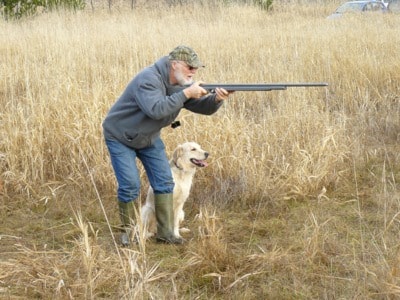There’s a good chance most of the dogs chasing bumpers in a Qualicum Bay field will never go on a real hunting trip, but Rick Yates makes a point of ensuring that if they do, they’ll be ready for the job.
Yates heads up a small band of retriever enthusiasts called the Golden Group, who meet every weekend in a rural field to train their Golden retrievers to be hunting dogs.
“We do simulated hunting tests,” Yates said. Most people who run their dogs never do actually hunt, they do it as a hobby to see how far they can take their dogs.”
Under Yates’ supervision, the dozen or so members of the group, throw bumpers out in the field for their dogs to chase, find and retrieve.
“The dog has to mark where they’re thrown, run out and retrieve the ‘bird,’” he said. “As puppies they are sent out on very short, 30-yard singles and when they get to six months they start doing about 40-yard singles. There’s a gunner out in the field who quacks, throws and shoots while the bumper is up in the air.”
The owner meanwhile, poses with a fake wooden shotgun, so the dog is used to the idea of what would happen in a real hunting situation.
Although real, dead ducks are sometimes used in the training, Yates said they are only used just prior to a test, to ensure the dogs know they’ll be going after real birds when they head down to Crofton for the big day.
That day, Yates said, involves testing by the Canadian Kennel Club, which gives out working certificates to beginner dogs and Junior Hunter certificates to more advanced retrievers.
As they advance, the requirements get more and more stringent.
“Once they pass the working certificate, they can go on to their junior hunting test,” Yates said. “In that, they go out into the field for 60 to 75 yards and get a single and when they return that to hand the owner then turns about 90 degrees and points them towards another gunner and another bird.”
It’s a little more complicated than that however, as the testers attempt to mimic situations that could arise in a real hunting situation.
“One of the things we do is to throw a diversion bird,” he said. “The dog has to return the first bird to hand before it is allowed to go after the second one.”
Once the dog passes the test its trial is not over. It must also pass the same test, but in water.
In the doubles test, Yates said he uses what is known as a memory bird, which is thrown first on the left, before a second bird is thrown on the right. The dog must retrieve the second bird to hand before remembering where the first bird fell and retrieving that, also.
Yates said he has been training Goldens for about 10 years, learning just as his students are learning — from someone who knew a little bit about the hunting dog protocol. In his case, the training took place in Mackenzie in north central B.C.
“It takes about four years to get to be a good hunting dog, but it takes about six months to the point where you can get to singles and be ready for a test” he said.
